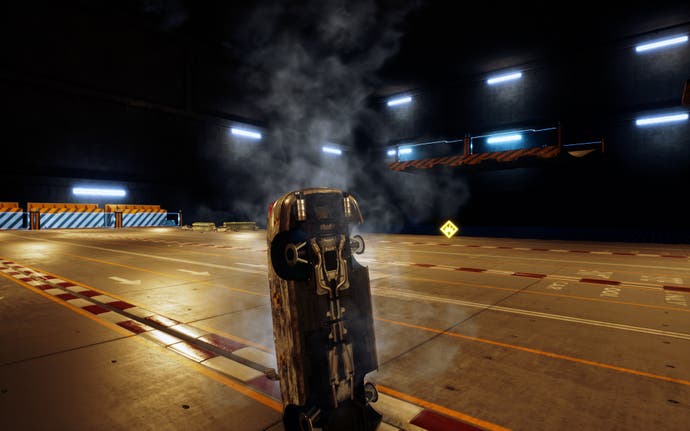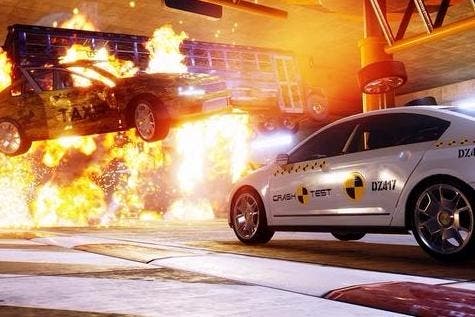Danger Zone review
Always crashing in the same car.
I don't like to watch the flythrough. I like to find everything out in the moment. And 'the moment', in Danger Zone, means the same moment your front bumper first kisses the front bumper of another vehicle travelling at high speed. Or maybe it kisses the tailgate, and sends everything into a spin. Or maybe it kisses the side, and all that momentum results in a skidding stop as metal grinds against metal. The flythrough is there to give you a chance to plan your route: first collision here, over to that Smashbreaker, over to that Smashbreaker, and then into that chain of points booster pickups. Done.
Yeah, done, I guess, but where is the fun in that? Planning still feels wrong here, no matter how precise Danger Zone becomes in some of its final demands on its players. Precision is one thing, but I like to find everything out in the moment.
Like traffic-checking. A guilty pleasure imported from Burnout Revenge, I think. Possibly a step too far at the time, even for a series that prided itself in stepping too far. Traffic-checking meant that you could smash into any car that was travelling in the same direction you were headed in, and you would just bat the car in question aside with no real loss of momentum, without it registering as a proper collision and taking you into that glorious thick-air slow-mo and then restart. Traffic-checking saw you Katamari-ing your way down a track, gathering up any nearby travellers who would then just bounce along with you in a chummy muddle, wiping out all incoming cars.
It was fun, but it was too much fun at times. It took over Revenge entirely when the moment grabbed me - and the moment always grabbed me. In Danger Zone, which is basically Burnout's Crash Mode, spun off as a standalone and lavished with standalone care, traffic-checking settles in really nicely, however. You can't use it on every course, but on a course like Tunnel Vision, say, where you practically spawn amidst a load of moving vehicles moving along with you, it works beautifully. It is another element to take into account, another factor to consider as you scramble up the leaderboards.
Danger Zone is Crash Mode, then, but Crash Mode has not been standing still all these years. Danger Zone reimagines Burnout's moreish Crash Junctions as something more elaborate, a symphony of moving parts, a bustling timeline into which you must choose not just the optimal space but the optimal moment to insert yourself. Put aside the tutorials and there are 20 crash scenarios to choose from here, spread across three test stages. At the start, you're dealing with pretty straightforward Crash Mode territory - not that that is in any way a slight when you're faced with a treat like this. You know the deal, though: a junction, cross-traffic, a bunch of pickups to bounce between.
Towards the middle of the twenty levels, however, things have grown baroque. You will spawn behind traffic. You will find your opening position leads you towards a ramp, and then you'll spend what seems like an age soaring through the air as a dual carriageway grows larger and deadlier on the horizon. Later levels are often like tiered wedding cakes piped with motorways, and you must find the right moment to tumble down a level, or perhaps blast yourself up a level. You must work out how to score the number of shunts that triggers your initial Smashbreaker - that explosive charge that is kicked off with a stab of the B button and that sees you launched into the sky as cars erupt around you - and then you must plot a path between all the other Smashbreaker tokens scattered nearby.
Increasingly, you must work out when to act. You must get to a distant highway by the time it is busy with traffic - because traffic can run dry here if you don't hit it at the right moment. Everything is an opportunity to boost your score, but everything is an opportunity to miss out on a score payout too. Maybe you're so fixated with collecting the score-boost pickups that you let the Smashbreakers run out. Maybe you're so fixated on keeping yourself in Smashbreakers that you miss the traffic. Maybe you're so fixated with all of these different elements that you forget the fact that if you fall off the road into the laser-abyss that surrounds it, it's game over. (Inevitably if you can knock traffic into the abyss you get extra points.)

In a strange, rather fitting, way, it is a restriction that has given Danger Zone much of its interesting new character. Beneath the care and attention, this is a game made on a tight budget, which is presumably part of the reason why its crash junctions and mutant intersections exist in the metal-textured limbo of a futuristic crash test chamber. But opting for a test chamber, and severing all links to the outside world, has allowed the spaces Danger Zone traverses to become increasingly fantastical - bridges to nowhere, junctions that form mazes - and that in turn has allowed the power-ups, both Smashbreakers and points-boosters - to knit themselves together to form a path through the chaos that always leads you to the greatest challenges and the highest scores. Throw in payloads to tip off lorries - you can earn money flinging toilets about here - and traffic of different values, and it's a game with immediacy and depth. (And a surprisingly speedy restart, too.)
One example makes my point, I think. Late in the game you'll find a test chamber in which the sprawling roads form a huge, unwieldy loop. You could never make it around this loop without a collision, but maybe you can use your collisions, and all the Smashbreakers scattered about, to carry you over the level from one patch of chaos to the next? It's ambitious for a Crash Junction, and it also exists in a wonderful space between something that's supremely exacting and something that rewards experimentation. I knew I had to hit my marks to complete this loop, but I also knew I had to find those marks in the first place. I spent at least two hours on this one level, watching my score grow as I played it safe, watching my score plummet as I tried something stupid, and finally, watching my score soar as I tried something truly, truly stupid.
And of course, all of this, the ingenuity and thrift of the design, the crash test carnage, the sheer tyre-grippy handling of the car as you race into battle, and the inertial heft as you force your wreckage from one disaster to the next, makes you yearn for something more. Burnout's been away too long, hasn't it? It's nice to have a little part of it back - back in the hands of people who understand it like nobody else.



